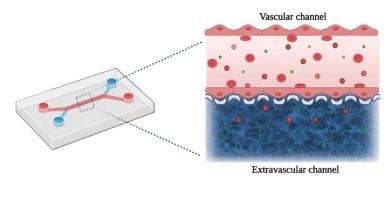Journal of Colloid and Interface Science ( IF 9.4 ) Pub Date : 2021-03-17 , DOI: 10.1016/j.jcis.2021.03.053 Maria Grazia Barbato 1 , Rui C Pereira 2 , Hilaria Mollica 3 , AnnaLisa Palange 2 , Miguel Ferreira 2 , Paolo Decuzzi 2

|
Hypothesis
The selective permeation of molecules and nanomedicines across the diseased vasculature dictates the success of a therapeutic intervention. Yet, in vitro assays cannot recapitulate relevant differences between the physiological and pathological microvasculature. Here, a double-channel microfluidic device was engineered to comprise vascular and extravascular compartments connected through a micropillar membrane with tunable permeability.
Experiments
The vascular compartment was coated by endothelial cells to achieve permeability values ranging from ~0.1 μm/sec, following a cyclic adenosine monophosphate (cAMP) pre-treatment (25 μg/mL), up to ~2 μm/sec, upon exposure to Mannitol, Lexiscan or in the absence of cells. Fluorescent microscopy was used to monitor the vascular behavior of 250 kDa Dextran molecules, 200 nm polystyrene nanoparticles (PB), and 1,000 × 400 nm discoidal polymeric nanoconstructs (DPN), under different permeability and flow conditions.
Findings
In the proposed on-chip microvasculature, it was confirmed that permeation enhancers could favor the perivascular accumulation of ~200 nm, in a dose and time dependent fashion, while have no effect on larger particles. Moreover, the microfluidic device was used to interrogate the role of particle deformability in vascular dynamics. In the presence of a continuous endothelium, soft DPN attached to the vasculature more avidly at sub-physiological flows (100 μm/sec) than rigid DPN, whose deposition was larger at higher flow rates (1 mm/sec). The proposed double-channel microfluidic device can be efficiently used to systematically analyze the vascular behavior of drug delivery systems to enhance their tissue specific accumulation.
中文翻译:

用于评估大分子和聚合物纳米结构运输的可渗透片上微血管系统
假设
分子和纳米药物在患病脉管系统中的选择性渗透决定了治疗干预的成功。然而,体外测定不能概括生理和病理微血管系统之间的相关差异。在这里,双通道微流体装置被设计成包括通过具有可调渗透性的微柱膜连接的血管和血管外隔室。
实验
血管隔室被内皮细胞包被,以达到约 0.1 μm/sec 的渗透率值,在环磷酸腺苷 (cAMP) 预处理 (25 μg/mL) 后,暴露于甘露醇后可达约 2 μm/秒, Lexiscan 或在没有细胞的情况下。荧光显微镜用于监测 250 kDa 葡聚糖分子、200 nm 聚苯乙烯纳米粒子 (PB) 和 1,000 × 400 nm 盘状聚合物纳米结构 (DPN) 在不同渗透性和流动条件下的血管行为。
发现
在提议的片上微血管系统中,证实渗透增强剂可以以剂量和时间依赖的方式促进约 200 nm 的血管周围积聚,而对较大的颗粒没有影响。此外,微流体装置被用来询问粒子变形能力在血管动力学中的作用。在存在连续内皮的情况下,软 DPN 在亚生理流量 (100 μm/sec) 下更热衷于附着在脉管系统上,而刚性 DPN 在较高流速 (1 mm/sec) 下沉积更大。所提出的双通道微流体装置可有效地用于系统地分析药物输送系统的血管行为,以增强其组织特异性积累。















































 京公网安备 11010802027423号
京公网安备 11010802027423号